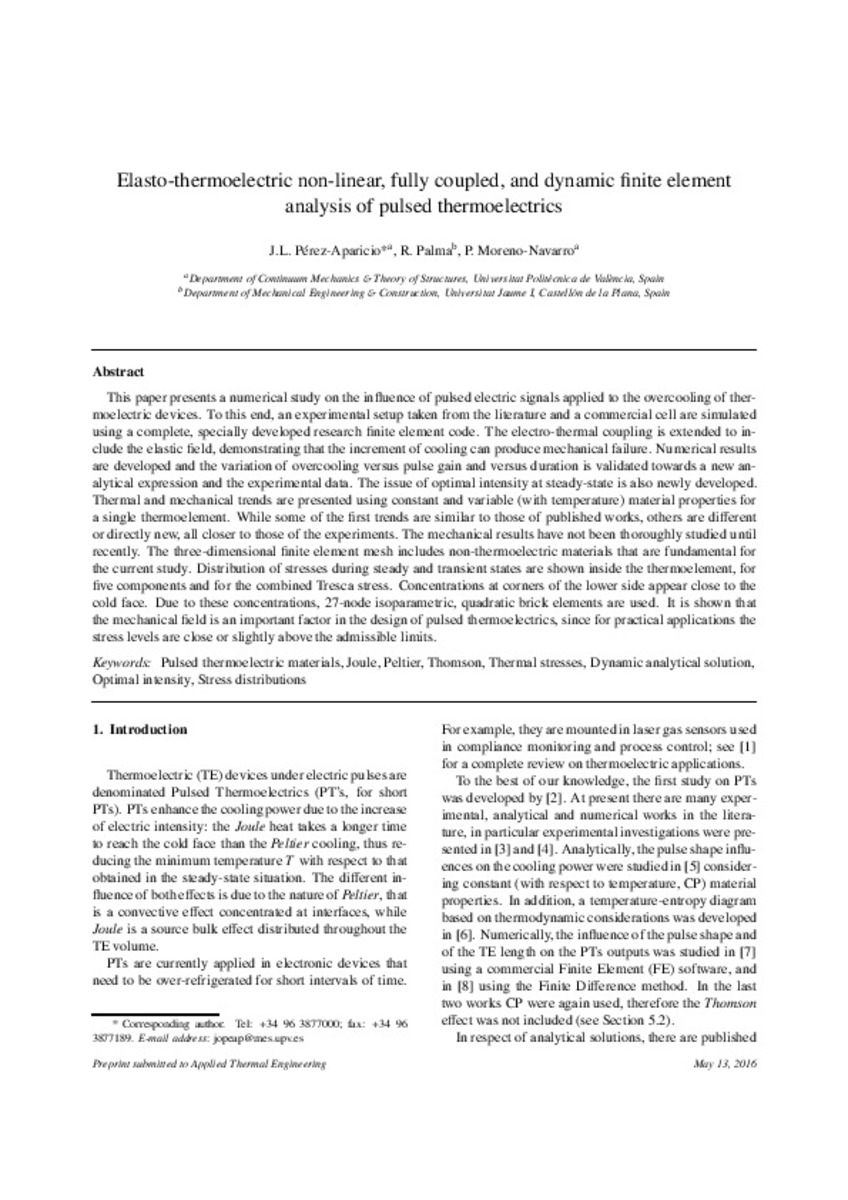Mostrar el registro sencillo del ítem
Elasto-thermoelectric non-linear, fully coupled, and dynamic finite element analysis of pulsed thermoelectrics
| dc.contributor.author | Pérez Aparicio, J. L. | |
| dc.contributor.author | Palma Guerrero, Roberto | |
| dc.contributor.author | Moreno Navarro, P. | |
| dc.date.accessioned | 2016-11-25T11:27:45Z | |
| dc.date.available | 2016-11-25T11:27:45Z | |
| dc.date.issued | 2016-08 | |
| dc.identifier.citation | PEREZ-APARICIO, J. L.; PALMA, R.; MORENO-NAVARRO, P. Elasto-thermoelectric non-linear, fully coupled, and dynamic finite element analysis of pulsed thermoelectrics. Applied Thermal Engineering, Volume 107, August 2016. | ca_CA |
| dc.identifier.uri | http://hdl.handle.net/10234/164724 | |
| dc.description.abstract | This paper presents a numerical study on the influence of pulsed electric signals applied to the overcooling of thermoelectric devices. To this end, an experimental setup taken from the literature and a commercial cell are simulated using a complete, specially developed research finite element code. The electro-thermal coupling is extended to include the elastic field, demonstrating that the increment of cooling can produce mechanical failure. Numerical results are developed and the variation of overcooling versus pulse gain and versus duration is validated towards a new analytical expression and the experimental data. The issue of optimal intensity at steady-state is also newly developed. Thermal and mechanical trends are presented using constant and variable (with temperature) material properties for a single thermoelement. While some of the first trends are similar to those of published works, others are different or directly new, all closer to those of the experiments. The mechanical results have not been thoroughly studied until recently. The three-dimensional finite element mesh includes non-thermoelectric materials that are fundamental for the current study. Distribution of stresses during steady and transient states are shown inside the thermoelement, for five components and for the combined Tresca stress. Concentrations at corners of the lower side appear close to the cold face. Due to these concentrations, 27-node isoparametric, quadratic brick elements are used. It is shown that the mechanical field is an important factor in the design of pulsed thermoelectrics, since for practical applications the stress levels are close or slightly above the admissible limits. | ca_CA |
| dc.description.sponsorShip | This research was partially supported by grants CSD2008-00037Canfranc Underground Physics and Polytechnic University of Valencia under programs PAID 02-11-1828 and 05-10-2674. | ca_CA |
| dc.format.extent | 11 p. | ca_CA |
| dc.format.mimetype | application/pdf | ca_CA |
| dc.language.iso | eng | ca_CA |
| dc.publisher | Elsevier | ca_CA |
| dc.relation.isPartOf | Applied Thermal Engineering Volume 107, August 2016 | ca_CA |
| dc.rights | © 2016 Published by Elsevier Ltd. | ca_CA |
| dc.rights.uri | http://rightsstatements.org/vocab/InC/1.0/ | * |
| dc.subject | Pulsed thermoelectric materials | ca_CA |
| dc.subject | Thermal stresses | ca_CA |
| dc.subject | Dynamic analytical solution | ca_CA |
| dc.subject | Optimal intensity | ca_CA |
| dc.subject | Stress distributions | ca_CA |
| dc.subject | Joule, Peltier, Thomson | ca_CA |
| dc.title | Elasto-thermoelectric non-linear, fully coupled, and dynamic finite element analysis of pulsed thermoelectrics | ca_CA |
| dc.type | info:eu-repo/semantics/article | ca_CA |
| dc.identifier.doi | http://dx.doi.org/10.1016/j.applthermaleng.2016.05.114 | |
| dc.rights.accessRights | info:eu-repo/semantics/openAccess | ca_CA |
| dc.relation.publisherVersion | http://www.sciencedirect.com/science/article/pii/S1359431116307827 | ca_CA |
Ficheros en el ítem
Este ítem aparece en la(s) siguiente(s) colección(ones)
-
EMC_Articles [807]







